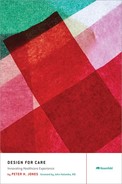FOREWORD
In 2012, my wife and I were partners on a cancer journey. She was diagnosed with stage IIIA breast cancer in December 2011, and the cycles of chemotherapy, surgery, and radiation therapy filled the first seven months of 2012. As a clinician, I reviewed every order, every note, and every plan in her Beth Israel Deaconess online medical record. As a patient, she viewed everything written about her in her Beth Israel Deaconess PatientSite personal health record. I cannot imagine how care coordination, shared decision making, and communication would have been possible without ubiquitous patient–provider access to all the data, knowledge, and wisdom related to her care.
In Design for Care, Peter Jones outlines the critical role of design in the wellness care of the future, ensuring that every provider and patient is empowered with the services and tools they need for healthcare quality, safety, and efficiency. His thoughtful analysis includes all the core concepts that are driving the US healthcare IT stimulus—policies and technologies that engage the patient, eliminate disparities, protect privacy, and prevent avoidable harm.
When I mentioned that my wife’s care required universal access to data, knowledge, and wisdom, what did I mean? Data includes the simple facts about her care—an appointment is made, a medication is given, a lab test has a result. Information is the interpretation of her data in a manner that is relevant to her care—her hematocrit at baseline is 39, and after chemotherapy it is 30. Her medications have caused side effects that may outweigh the benefits of the drug. Wisdom is applying decision support rules to her information that optimizes her care. Because her tumor is estrogen positive, progesterone positive, and HER2 negative, the best therapy is Cytoxan/Adriamycin/Taxol. Her accumulated radiation dose from all the mammograms, CT scans, and other studies is concerning, and thus ultrasound should be used when possible.
We clearly need better ways to move between data and information to knowledge and wisdom in today’s complex healthcare world. This book illustrates these points and emphasizes the need for patients and providers to embrace a wise integration of technology into healthcare service.
Meaningful use and care improvements through universal adoption of electronic tools is just one of the major trends in the era of healthcare reform. “Patient-centered medical homes,” “accountable care organizations,” and “population health” are the new buzzwords. We need to rethink and actually design the new models of service, institutional practice, and patient engagement that ensure these new institutions become innovative alternatives to the care model, and don’t simply replicate business as usual. The new concept is that care is no longer episodic, but continuous. Patients are engaged in their daily lives, and the emphasis is no longer on the treatment of illness but the preservation of wellness, maximizing functional status and care according to the preferences of the patient.
Peter Jones examines the kinds of innovations that are moving care away from academic health centers and into the community and homes. This trend is essential—healthcare in the United States consumes 17% of the gross domestic product. It is a poor value, with significant cost and less than stellar outcomes. To bend the cost curve and create high-value care, it is wise to follow the recommendations outlined in this book. Embrace technology, but design it well and consider its future trajectory and how it affects safety and interaction with patients. Engage the patient and innovate in ways that focus on longitudinal wellness rather than episodic encounters for illness.
I am confident you will find this book a helpful road map to guide your own journey to improve health and healthcare.
—John Halamka, MD
Chief Information Officer, Beth Israel Deaconess Medical Center, Boston
